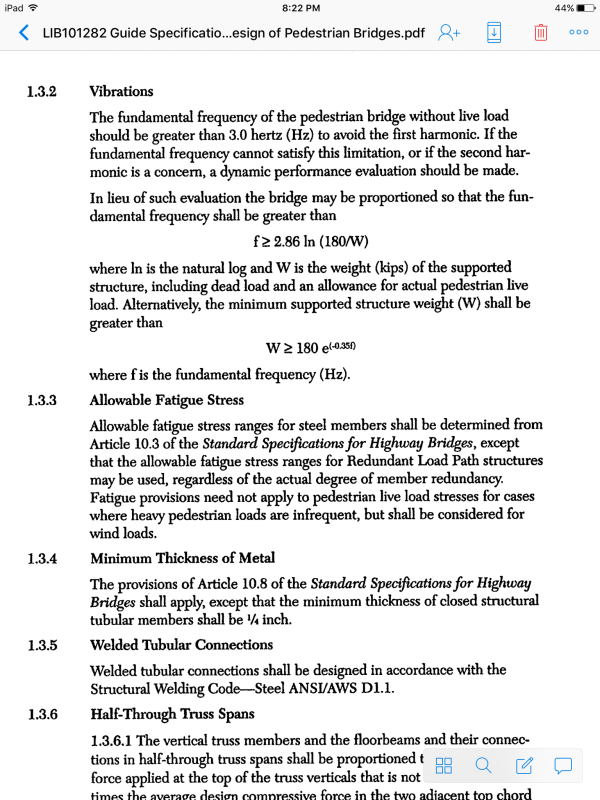Agent666
Structural
- Jul 2, 2008
- 3,080
Hi
We have a pedestrian/cycle bridge to design which has multiple simply supported spans of ~11.5m length, with lightweight timber deck + handrail/barrier.
We were hoping for simplicity that we could use 2 simply supported steel beams between intermediate supports (one either side of the deck) with some steel cross members supporting timber joists with timber decking.
I am currently working out vibration performance in accordance with AISC design guide 11 (second edition), our code also refers us specifically also to a procedure in appendix C of BS5400 bridge standard that we need to demonstrate compliance with.
The BS5400 design guidance notes for bridges with the 1st fundamental frequency greater than 5 Hz that a specific assessment is not required. Our first cut beam size was such that the natural frequency was just under 5 Hz, so we then went about evaluating the max acceleration only to find it was about 70%g under running excitation when worked out in accordance with AISC design guide 11 …..(lightweight decking and only 1% damping, so not surprising to us after rechecking the numbers (essentially following the design example 4.5 in DG11)).
The question is, I could have a structure just over 5Hz that would by the code not require a specific evaluation of accelerations, but if I do evaluate the max acceleration with the higher than 5Hz fundamental frequency, then we find it is an order of magnitude greater than any commonly accepted acceleration limits. For example even we much stiffer beams and a 9Hz fundamental frequency, we still evaluate about a 30%g acceleration.
Are we safe to ignore this as being above 5Hz means lesser chance of stepping action exciting the span? Or should we irrespective of the fundamental frequency adhere to some acceleration limits because they might occur in accordance with what is being estimated by DG11? I guess more than anything after working out this large acceleration I'm not 100% convinced we should be ignoring it.
AISC design guide 11 suggests a 5%g acceptable limit for an outdoor footbridge, which seems quite onerous if we need to make this work.
If we do need to meet some acceleration limits even with >5Hz, what is appropriate?
Any advice based on previous experience with similar is appreciated, as it’s the first time we have looked at a footbridge, usually for vibration of composite beams we have more mass and damping and it just works (most of the time).
We have a pedestrian/cycle bridge to design which has multiple simply supported spans of ~11.5m length, with lightweight timber deck + handrail/barrier.
We were hoping for simplicity that we could use 2 simply supported steel beams between intermediate supports (one either side of the deck) with some steel cross members supporting timber joists with timber decking.
I am currently working out vibration performance in accordance with AISC design guide 11 (second edition), our code also refers us specifically also to a procedure in appendix C of BS5400 bridge standard that we need to demonstrate compliance with.
The BS5400 design guidance notes for bridges with the 1st fundamental frequency greater than 5 Hz that a specific assessment is not required. Our first cut beam size was such that the natural frequency was just under 5 Hz, so we then went about evaluating the max acceleration only to find it was about 70%g under running excitation when worked out in accordance with AISC design guide 11 …..(lightweight decking and only 1% damping, so not surprising to us after rechecking the numbers (essentially following the design example 4.5 in DG11)).
The question is, I could have a structure just over 5Hz that would by the code not require a specific evaluation of accelerations, but if I do evaluate the max acceleration with the higher than 5Hz fundamental frequency, then we find it is an order of magnitude greater than any commonly accepted acceleration limits. For example even we much stiffer beams and a 9Hz fundamental frequency, we still evaluate about a 30%g acceleration.
Are we safe to ignore this as being above 5Hz means lesser chance of stepping action exciting the span? Or should we irrespective of the fundamental frequency adhere to some acceleration limits because they might occur in accordance with what is being estimated by DG11? I guess more than anything after working out this large acceleration I'm not 100% convinced we should be ignoring it.
AISC design guide 11 suggests a 5%g acceptable limit for an outdoor footbridge, which seems quite onerous if we need to make this work.
If we do need to meet some acceleration limits even with >5Hz, what is appropriate?
Any advice based on previous experience with similar is appreciated, as it’s the first time we have looked at a footbridge, usually for vibration of composite beams we have more mass and damping and it just works (most of the time).

